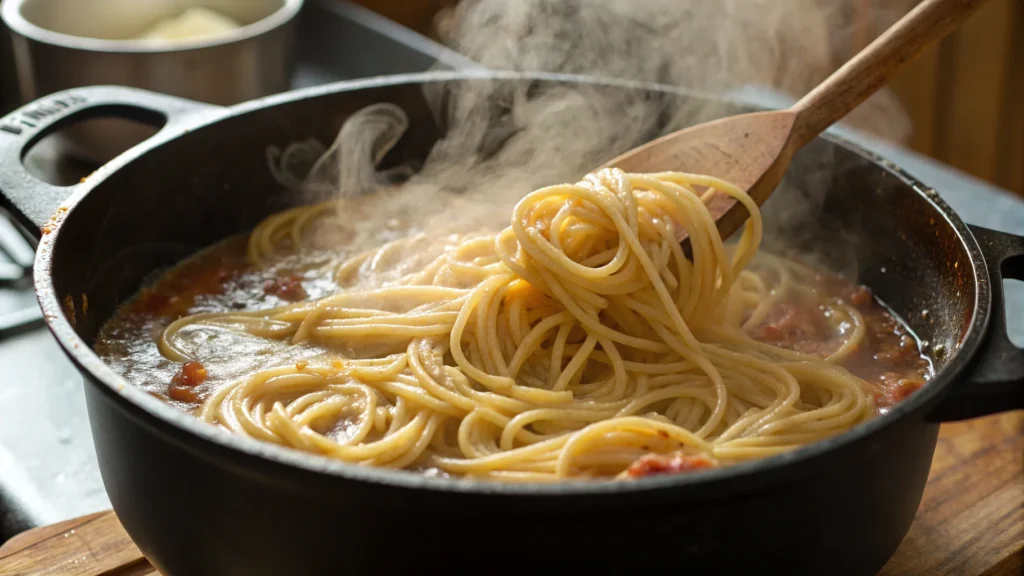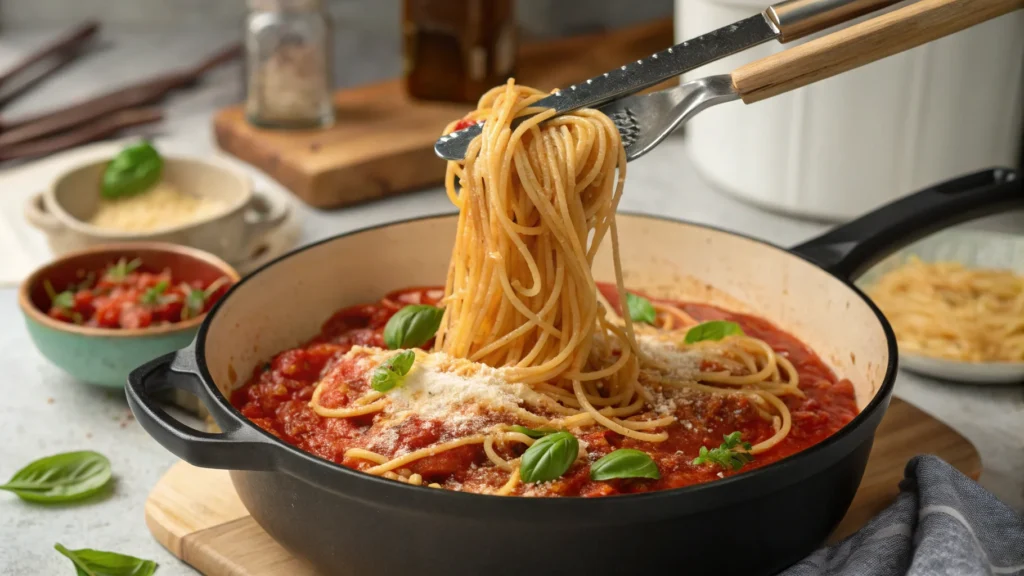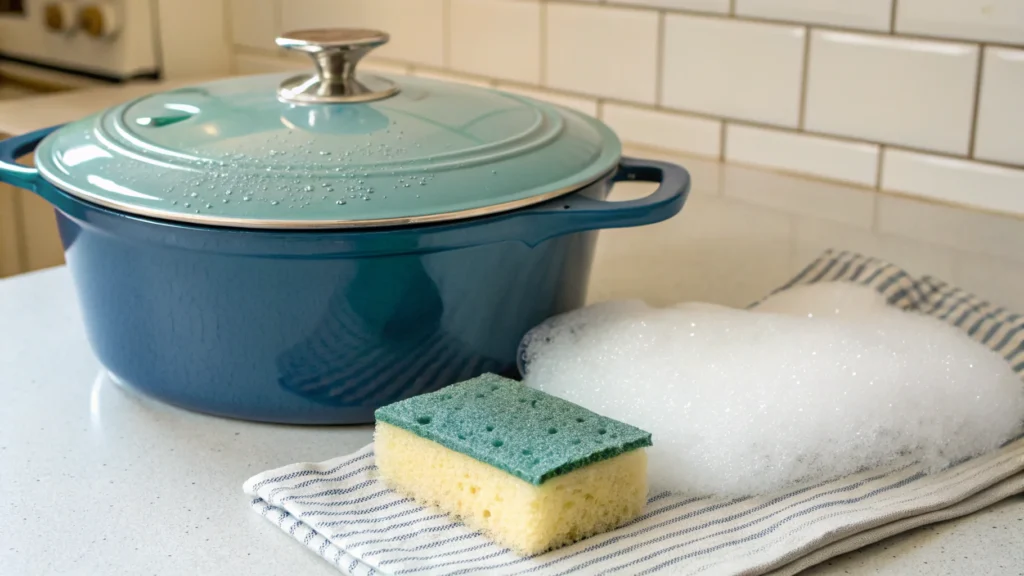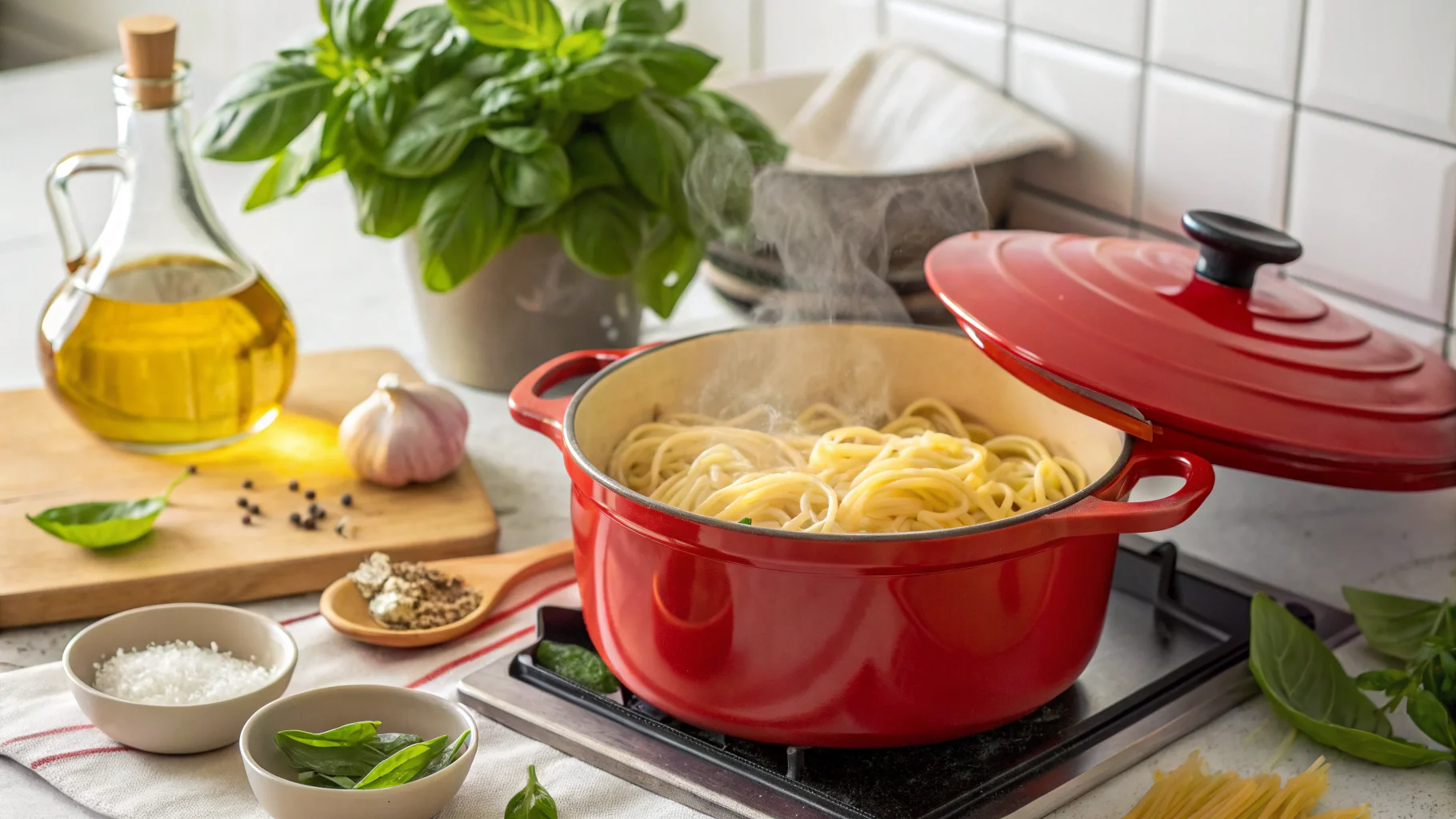Cooking pasta in a Dutch oven can be a culinary delight or a sticky mess, depending on how you approach it. This article dives into tried-and-true methods to keep your pasta from sticking, exploring everything from understanding the causes of sticking to choosing the right Dutch oven and perfecting your cooking techniques. You’ll also learn how to clean and maintain your Dutch oven to ensure stress-free cooking. Let’s get started with the first step—understanding why pasta sticks in the first place.
Table of contents
- Why Does Pasta Stick in a Dutch Oven?
- Choosing the Right Dutch Oven
- Pre-Cooking Preparation
- Cooking Techniques for Sticking Prevention
- The Role of Oil and Sauce in Non-Sticky Pasta
- Tips for Different Pasta Types
- Cleaning and Maintaining Your Dutch Oven
- Pro Tips for Perfect Pasta Every Time
- FAQs Section
- Conclusion
Why Does Pasta Stick in a Dutch Oven?
Cooking pasta should be simple, but if you’ve ever ended up with clumps of sticky noodles, you’re not alone. Understanding why this happens is the first step to fixing it.
The Science Behind Sticking
When pasta cooks, its starch molecules are released into the water, creating a sticky surface. In a Dutch oven, which retains heat exceptionally well, this starch can cling to the pot’s interior. This happens more when the water-to-pasta ratio is too low, leaving less water to dilute the starches.
Additionally, the type of Dutch oven matters. Unseasoned cast iron or damaged enamel coatings are more likely to encourage sticking because their surfaces lack the necessary slickness.
Common Triggers: Temperature, Surface, and Water Ratios
High temperatures can exacerbate sticking, especially if the pasta is added before the water reaches a rolling boil. Without vigorous boiling, the starch doesn’t disperse properly, and pasta can cling to the pot.
Another culprit is insufficient water. If the noodles don’t have enough room to move freely, they’ll stick together and to the pot. Using an improperly prepared Dutch oven, such as one with scratches or a dry surface, also increases the likelihood of sticking.
Choosing the Right Dutch Oven
When it comes to preventing pasta from sticking, the type of Dutch oven you use makes all the difference. A well-chosen Dutch oven not only cooks pasta evenly but also minimizes sticking issues altogether. Here’s what you need to know.
Material Matters: Cast Iron, Enamel, or Non-Stick
Dutch ovens come in various materials, and each one has its strengths. For pasta, an enameled Dutch oven is a fantastic choice because its smooth surface resists sticking better than bare cast iron. If you’re using cast iron, make sure it’s well-seasoned to create a naturally non-stick surface.
Non-stick Dutch ovens are another option, but they’re not always the best for high-heat cooking, which is essential for boiling pasta. How do you keep pasta from sticking to a Dutch oven? It starts by selecting the right material that ensures consistent heating and minimal sticking.
Size and Depth for Optimal Pasta Cooking
The size of your Dutch oven is just as important as the material. A pot that’s too small won’t allow the pasta to move freely, leading to clumping and sticking. Ideally, choose a Dutch oven that can hold at least 5-6 quarts for boiling pasta. Deeper pots are particularly helpful for long noodles like spaghetti, allowing them to submerge completely without breaking.
Pre-Cooking Preparation
The secret to avoiding sticky pasta often lies in how you prepare your Dutch oven and ingredients before cooking. With the right prep work, you can make sticking a thing of the past.
Seasoning and Prepping the Dutch Oven
If you’re using a cast iron Dutch oven, seasoning it properly is crucial. A seasoned pot develops a natural, non-stick coating over time. For enameled Dutch ovens, ensure the surface is clean and free of scratches, which can trap starches and cause sticking.
Before you even add water, lightly coat the bottom of the Dutch oven with a thin layer of oil. While it won’t make your pasta oily, it creates an extra barrier against sticking. How do you keep pasta from sticking to a Dutch oven? Preparing the pot is step one!
Pre-Boiling the Water: Salt and Temperature Tips
Bringing the water to a rolling boil is a must. Adding pasta to lukewarm or slow-boiling water increases the chances of it sticking together and to the pot. And don’t forget the salt! Salted water not only flavors the pasta but also helps reduce sticking by altering the starch release process.
For optimal results, use about 1 tablespoon of salt per 4-5 quarts of water. Stir the water after adding the salt to ensure it dissolves evenly. These simple steps go a long way toward keeping your pasta smooth and separate.

Cooking Techniques for Sticking Prevention
When cooking pasta in a Dutch oven, a few simple techniques can make all the difference. By focusing on timing, stirring, and water ratios, you can prevent sticking and enjoy perfect pasta every time.
Stirring Intervals: When and How Often?
One of the most effective ways to keep pasta from sticking is stirring it at the right times. Right after adding pasta to the boiling water, give it a thorough stir to prevent clumps from forming. Continue stirring every few minutes, especially during the first five minutes, when the pasta releases the most starch.
This proactive approach ensures that the noodles move freely, minimizing their contact with the pot’s surface. Remember, the key to how do you keep pasta from sticking to a Dutch oven lies in consistent attention.
Avoid Overloading: Ideal Pasta-to-Water Ratio
A common mistake is using too little water for the amount of pasta being cooked. To prevent sticking, ensure there’s plenty of space for the pasta to circulate. Use at least 4 quarts of water per pound of pasta. In a Dutch oven, which heats water evenly, this ratio helps dilute starch and keeps noodles from clumping.
Heat Management: Keeping It Consistent
Maintaining a steady boil is another critical factor. If the water temperature drops too much after adding pasta, it won’t cook evenly, and noodles may stick together. Keep the heat on medium-high to maintain a rolling boil throughout the cooking process.

The Role of Oil and Sauce in Non-Sticky Pasta
Adding oil and tossing with sauce are time-tested methods to combat sticky pasta. Let’s explore how to use these tricks effectively.
When to Add Oil to Pasta
Adding a tablespoon of oil to the water is a debated topic. While it won’t completely prevent sticking, it can help create a thin barrier on the pasta surface. However, the more practical use for oil is tossing the cooked pasta before serving. This ensures that the noodles remain slippery and separate, especially if you’re serving them plain.
Tossing Pasta in Sauce: Timing and Techniques
For the best results, toss the pasta in the sauce immediately after draining it. The sauce coats the noodles and keeps them from sticking together. In fact, tossing pasta with a small amount of its cooking water can help emulsify the sauce, creating a velvety texture.
If you’re interested in more ideas, check out this guide on cooking spaghetti and meatballs in a Dutch oven for a delicious way to pair pasta with sauce.
Tips for Different Pasta Types
Different pasta types require slight adjustments to ensure they cook perfectly without sticking. By tailoring your techniques to fresh, dried, or gluten-free pasta, you’ll always get great results.
Fresh Pasta vs. Dried Pasta: Key Differences
Fresh pasta contains more moisture than dried pasta, making it more prone to sticking. To prevent this, use plenty of water when cooking fresh pasta and stir it frequently. Because fresh pasta cooks faster, keep an eye on it to avoid overcooking, which can make it gummy and more likely to stick.
Dried pasta, on the other hand, releases more starch as it cooks. To combat this, always bring the water to a full boil before adding the pasta. How do you keep pasta from sticking to a Dutch oven? Whether it’s fresh or dried, proper water volume and stirring are key.
Special Considerations for Gluten-Free Pasta
Gluten-free pasta, often made from rice, corn, or quinoa, can be especially sticky due to its higher starch content. To avoid clumping, add a splash of oil to the water and stir frequently throughout cooking. Draining gluten-free pasta promptly and rinsing it lightly can also help reduce stickiness.

Cleaning and Maintaining Your Dutch Oven
Keeping your Dutch oven in good condition is essential for preventing sticking and prolonging its lifespan. Proper cleaning and maintenance go a long way toward ensuring a smooth, non-stick surface.
Removing Stuck Residue Safely
If pasta does stick to your Dutch oven, resist the urge to scrape it off with a metal utensil, as this can damage the surface. Instead, soak the pot in warm, soapy water for 15–20 minutes to loosen the residue. For tougher spots, use a soft sponge or nylon scrubber to gently remove the buildup.
Preventing Future Sticking Issues
Regular maintenance is crucial for keeping your Dutch oven ready for hassle-free cooking. If you use a cast iron Dutch oven, re-season it periodically to maintain its natural non-stick properties. For enameled versions, avoid using abrasive cleaners that can scratch the coating.
To see how to get the most out of your Dutch oven, check out this helpful guide on cooking spaghetti in a Dutch oven.
Pro Tips for Perfect Pasta Every Time
To achieve flawless pasta, a few extra tips can make all the difference. These practical ideas ensure that your pasta doesn’t stick while maintaining the perfect texture.
The Importance of Timing and Patience
Rushing the process often leads to sticky pasta. Always wait for the water to boil vigorously before adding noodles, and avoid overcrowding the pot. Set a timer to ensure you don’t overcook the pasta, as this can make it mushy and more prone to sticking.
Mastering the Art of Draining and Tossing
Draining pasta correctly is crucial for preventing clumps. Use a colander to remove excess water, but leave a small amount of pasta water behind. This starchy liquid helps the sauce cling to the noodles, creating a silky texture. Tossing the pasta immediately with sauce or a drizzle of oil keeps it from sticking while enhancing flavor.
For more expert tips on making pasta like a pro, check out this recipe for spaghetti and meatballs in a Dutch oven.
FAQs Section
When cooking pasta in a Dutch oven, it’s common to have questions about best practices. Let’s address some frequently asked questions to ensure your pasta turns out perfectly every time.
How Do I Stop Pasta From Sticking Without Oil?
While adding oil is a common tip, it’s not the only solution. The best way to keep pasta from sticking is by stirring frequently, especially during the first few minutes of cooking. Make sure the water is at a rolling boil before adding pasta and use plenty of water to dilute the starch. These steps often eliminate the need for oil altogether.
Why Does My Pasta Always Stick Even When I Stir?
If your pasta is still sticking despite regular stirring, it could be due to insufficient water or low cooking temperatures. Using a Dutch oven, which retains heat evenly, is ideal for maintaining a steady boil. Also, don’t overcrowd the pot; give your pasta enough space to move freely. Remember, how do you keep pasta from sticking to a Dutch oven? A combination of water volume, heat, and consistent stirring is key.
Can I Cook Pasta in a Dutch Oven Without Water?
Technically, you can cook pasta in sauce alone, but it’s trickier to prevent sticking. When doing this, add extra liquid to the sauce and stir frequently to keep the noodles from clumping. If you’re using this method, a non-stick Dutch oven or enameled version is your best bet.
Conclusion
Cooking pasta in a Dutch oven doesn’t have to end in a sticky mess. By understanding the causes of sticking, choosing the right pot, and following simple techniques like proper stirring and heat management, you can enjoy perfectly cooked pasta every time. Whether you’re cooking fresh, dried, or gluten-free pasta, these tips ensure that your noodles stay smooth and separate.
How do you keep pasta from sticking to a Dutch oven? The answer lies in preparation, attention to detail, and a few proven tricks. With the right approach, your Dutch oven can become your favorite tool for making delicious, hassle-free pasta dishes.
Want more cooking inspiration? Don’t miss our other guides and recipes for mastering the art of cooking with a Dutch oven!

